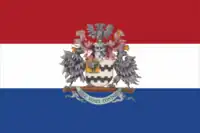The Republic of Graaff-Reinet | |||||||||||
|---|---|---|---|---|---|---|---|---|---|---|---|
| 1795–1796 | |||||||||||
 The flag of the republic. The flag was also used as the flag of the Republic of Swellendam and the flag of the Netherlands
 Coat of arms
| |||||||||||
| Motto: Dieu Nous Conduise (French: God Leads Us) | |||||||||||
  | |||||||||||
| Largest city | Graaff-Reinet | ||||||||||
| Official languages | Dutch | ||||||||||
| Recognised regional languages | Afrikaans, Xhosa and other native languages | ||||||||||
| Ethnic groups (1797) | Black Africans 63.13%
European 30% Slaves 6.8% | ||||||||||
| Religion | Dutch Reformed | ||||||||||
| Government | |||||||||||
• President | Marthinus Prinsloo | ||||||||||
| Independence from the Kingdom of the Netherlands | |||||||||||
| History | |||||||||||
• Revolt Against the Dutch | 1795 | ||||||||||
• British Invasion of the Cape | 1796 | ||||||||||
| Population | |||||||||||
• 1797 census | 14,173 | ||||||||||
| Currency | Dutch Rijksdaalder | ||||||||||
| |||||||||||
| Today part of | South Africa | ||||||||||
| Historical states in present-day South Africa |
|---|
 |
|
|
The Republic of Graaff-Reinet was from 1795 to 1796 a self-proclaimed Boer republic that existed in and around the city of Graaff-Reinet in present-day South Africa.[1] It was named after Cornelis Jacob van de Graaff and his wife, Cornelia Reynet.
History
In the 18th century, the first mounted commandos of the Dutch settlers reached the area where Graaff-Reinet currently lies. They moved east from the Cape Colony. The first farms were established in the 1770s. In the first years there was anarchy and lawlessness in the area. After a new magistrate was sent to the region to maintain law and order, the peaceful development of the settlement could begin. In 1795, after years of oppression by the Dutch East India Company (VOC), the inhabitants proclaimed a republic. The residents of Swellendam also did this (see map). Before the leaders of the Cape Colony could retake the new republics, the Cape Colony (together with the two rebellious areas) was itself conquered by Great Britain in 1795 (and Graaff-Reinet until August 1796). After the Netherlands regained the Cape Colony from the British, it was finally taken over by the British in 1806. Many inhabitants of the colony were very dissatisfied with this. For this reason, especially many people from the Graaff-Reinet district participated in the Great Trek.[2]


References
- ↑ "Graaff Reinet History".
- ↑ Giliomee, Hermann. Die Afrikaner, ʼn Biografie.